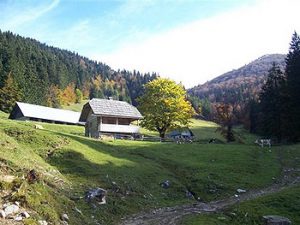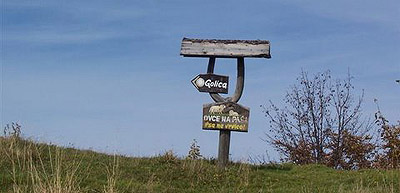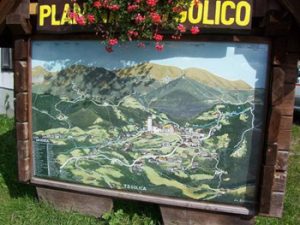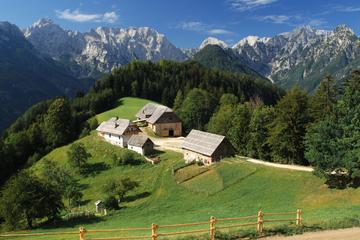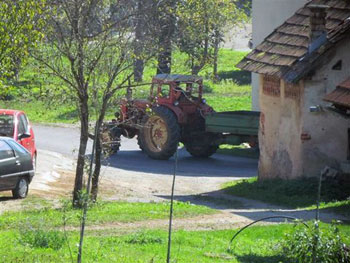
Gabrovka, Slovenia
by Larry Zaletel
Through the breaks in the clouds we begin to see the mountains slowly pass beneath us as we first glimpse the villages and green valleys of Slovenia below. “There may be a vintage when you arrive,” my cousin had exclaimed on the telephone before we left home. I am really looking forward to picking grapes with my family. However upon our arrival in Slovenia my wife and I learn that the grapes were picked the day before as the grapes and weather conditions were favorable. It is mid September and abnormally warm for this time of year.
The Village
 It is an awakening visiting the country of my family’s heritage. There is much to see and learn, understanding about the village and adjusting to the differences in customs, the diversity of rural life and the outlook on life in general. This is an opportunity to observe and live village life on a daily basis.
It is an awakening visiting the country of my family’s heritage. There is much to see and learn, understanding about the village and adjusting to the differences in customs, the diversity of rural life and the outlook on life in general. This is an opportunity to observe and live village life on a daily basis.
We are in the village of Gabrovka two kilometers down a narrow winding road from Zagradec, Slovenia. It is located amidst the mountains of the province of Dolenjska, nine kms from Ivancna Gorica and 30 kms southeast of Ljubljana. It is a small village with about 23 families; a pastoral community of green rolling hills surrounded by farms and dotted with abundant forest. Although the age of the village is uncertain the small village church of Saints Primus and Felician up the hill from the house where we are residing dates back to the 16th century.
The current family home is situated just behind where the old homestead was located until it was demolished in 2009. Unoccupied since the 1990s it had deteriorated as time and the elements wreaked havoc on the stone, brick, and limestone walls. Its mortared walls were crumbling to the point that they were becoming a hazard. Built sometime in the early 1800s the old homestead was where my grandfather was born. He left his home as a young man to journey across the ocean to America and settled in Cleveland, Ohio.
Morning in the Village
 I faintly hear the sounds of a rooster crowing somewhere in the valley and also ringing faintly in the distance is the sound of church bells from the Church of the Assumption in Zagradec. The sunlight begins to invade the room and my slumber is shattered by the heavy gong of the bells of Saint Primoz. Added to this myriad of sounds a tractor heads out to the fields just beyond the village edge.
I faintly hear the sounds of a rooster crowing somewhere in the valley and also ringing faintly in the distance is the sound of church bells from the Church of the Assumption in Zagradec. The sunlight begins to invade the room and my slumber is shattered by the heavy gong of the bells of Saint Primoz. Added to this myriad of sounds a tractor heads out to the fields just beyond the village edge.
It is a warm Saturday morning and we venture up the street to explore the village. Around the corner a very old house with rickety wooden stairs and front porch is to be torn down and replaced by a new home. Many of the homes date back over a hundred years and are made of stone and mortar. They represent the history of the village; others relatively new are built of orange stone tile whose exterior is covered with a white cement coating. The newer homes are brighter on the inside, spacious and with larger windows. Many are built on the weekends by the families themselves with the assistance of friends and take years to complete. The land is kept in the family and passed down through the generations. There is also a farmhouse or two complete with barns, cows and chickens. We pass a woman sweeping and cleaning outside around her home. She glances up and looks at our unfamiliar faces seeing the outsiders who have invaded the village. We slowly walk by and say “Dobro jutro” (good morning); she smiles faintly and continues her sweeping. Across the street another woman is digging in her flower box that is attached to the railing of the house.
My cousin is out and invites up onto the terrace for a visit. The terrace provides a good view of the village below and out into the distance overlooking the valley is Zagradec. He returns shortly with Cvicek wine a Dolenjska favorite. It is a dry red wine and somewhat sour. Cvicek is synonymous with Dolenjska and is just about unknown outside of Slovenia.
Later we reach the top of the hill overlooking the village. There before us is a panoramic view of the church, farms and homes of Gabrovka visible beneath us. Beyond, the fields are being tended and in the distance on the opposite side of the valley the tree covered mountains overlook Zagradec. The trees are just starting to turn colors into their autumnal hues of orange, gold, and red. Horses are quietly grazing in the fields and the occasional sounds of cows mooing can also be heard.
Farming
Much of the arable land in the village is farmed and tractors can be heard moving down the lanes during the early morning and evening hours. I am told that farming is not profitable enough to provide a good living in Slovenia. Therefore most people have mixed farms which mean that they also have day jobs so the farm work is done in the evenings and weekends. Now at the end of the growing season the villagers harvest the remaining vegetables of tomatoes, potatoes, cabbage etc. They are busy clearing the land, turning it over, and putting it to sleep for the winter. The plots of land some neatly plowed ready for the winter’s cold winds, some planted with winter crops like rye and others lay fallow rejuvenating themselves for a future crop. In the fall the villagers’s cut wood from their forest, and store it for the upcoming winter. The grape vineyards having been picked are mostly bare.
Groceries
 Good fresh bread does not last long in Slovenia due to the lack of preservatives so frequent trips to the market are required. To obtain groceries and bread we drive to Ivancna Gorica, a city complete with a small train station. The rail line connects Ljubljana and Novo Mesto and is used by passengers. Ivancna Gorica has a population of about 14,000 people and grocery stores of Mercator, Tus, and Hofer. Hofer is the Slovenian version of Aldi. The Mercator soon is our favorite. It is somewhat larger than the others and has a better selection of groceries. We obtain certain staples that should last us for the duration and learn quickly the differences between grocery stores in Slovenia and the United States. The cuts of meat are not the same so we must make due and improvise. It has been a long time since we ate brown eggs (jajce). We were able to purchase some in the Mercator and they were good. But the best and tastiest were provided by some of the neighbors in the village. They have thick shells and rich yellow yolks. We enjoy them for breakfast in the morning and they are delicious with ham (sunka). One day we have a taste for hotdogs or wieners and they have a variety with pork, beef, and some with horsemeat. However they are just not the same, but their homemade sausage is tastier.
Good fresh bread does not last long in Slovenia due to the lack of preservatives so frequent trips to the market are required. To obtain groceries and bread we drive to Ivancna Gorica, a city complete with a small train station. The rail line connects Ljubljana and Novo Mesto and is used by passengers. Ivancna Gorica has a population of about 14,000 people and grocery stores of Mercator, Tus, and Hofer. Hofer is the Slovenian version of Aldi. The Mercator soon is our favorite. It is somewhat larger than the others and has a better selection of groceries. We obtain certain staples that should last us for the duration and learn quickly the differences between grocery stores in Slovenia and the United States. The cuts of meat are not the same so we must make due and improvise. It has been a long time since we ate brown eggs (jajce). We were able to purchase some in the Mercator and they were good. But the best and tastiest were provided by some of the neighbors in the village. They have thick shells and rich yellow yolks. We enjoy them for breakfast in the morning and they are delicious with ham (sunka). One day we have a taste for hotdogs or wieners and they have a variety with pork, beef, and some with horsemeat. However they are just not the same, but their homemade sausage is tastier.
Automobile
During our visit our rental car a red Fiat with Croatian license plates was parked in the front of the family home. It appears that a local villager called a family member because they thought that the property was sold and that the new occupants had moved in. We were glad that the villagers were watchful and observant. However news does move fast in a small village.
Other Observations
A truck visits the villages regularly with necessities for those who can’t go to the market or store. The truck can be heard from a distance because over the loudspeaker system they play a Slovenian polka, “Moj Ocka Ima Konjicka Dva” (My Father has Two Horses).
I also notice that in the village the world moves slower and life is unhurried and quieter. Although we are out of the mainstream we keep up with the news of the world through the facilities of the library in Ivancna Gorica. Yet surprisingly over the space of our visit the world continues and nothing really changes much. We were sad to hear on Thursday 9/29/2011 that Lojze Slak, one of Slovenia’s most popular folk music accordionists had passed away overnight. Later in the evening there were numerous programs on the television and on the radio in his memory and Radio Straka 94.6 also played Lojze Slak music in his memory.
Ljubljana Food and Wine Walking Tour
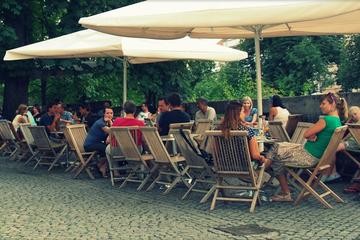
Taste of Ljubljana: Charcuterie, Cake and Wine on a Guided Walking Tour
If You Go:
About the author:
Larry Zaletel is a freelance travel writer, an avid, dedicated traveler, and recurring visitor to Europe. He writes about the various people and places that he has met and have visited during his travels.
All photographs are by Larry Zaletel:
Tractor in the village of Gabrovka
Overlooking the village of Zagradec from the village of Gabrovka
Grocery Truck in Gabrovka
Maribor, Slovenia border crossing between Austria and Slovenia


